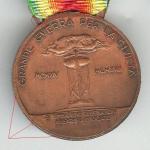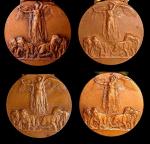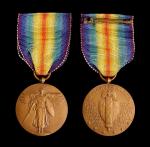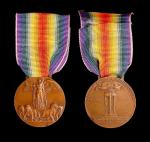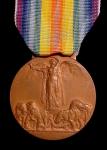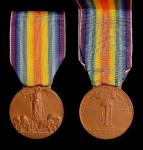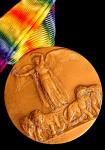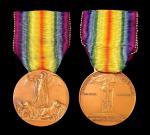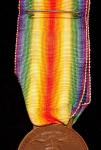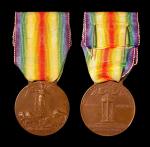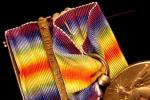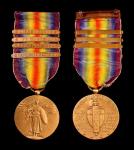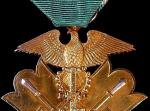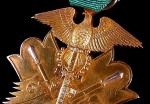
Tim B
Past Contributor-
Posts
2,234 -
Joined
-
Last visited
-
Days Won
2
Content Type
Profiles
Forums
Blogs
Gallery
Events
Store
Everything posted by Tim B
-
Italian Victory Medals
Tim B replied to Kev in Deva's topic in Inter-Allied Victory Medals of the Great War
Hi Rob! That's an interesting variation on the Lorioli-Castelli, never seen one before. On the unmarked one I posted/inquired about(reissue type 2/Unofficial type1/Repro type 3), I guess you have to be able to handle them and compare in hand to really tell the differences. The photo I showed is of course by "that" seller and knowing that he habitually uses stock photos to sell his stuff, I have not dealt with him after my first (and last) dealing with him. As most don't provide a size dimension, how would you tell without being able to handle and compare in a side by side comparison? I went back to take a closer look at the photos on this one and though the strike seems weak on both examples, I do see some signs I don't like on the one I posted photos of (again, not my medal). The overall soft look to the details, does lead me to believe this is a casting of an original. Looking at the red circles in the below photo, you can see the weaker than normal strike in the letters, but also the edge striations appear to be file marks (red arrows) while the top circle appears unfiled. Also note the Staffa area where there appears to be flaws at both ends. Umm; if this guy is spitting out fakes, then he must be making a killing on these. Tim -
Italian Victory Medals
Tim B replied to Kev in Deva's topic in Inter-Allied Victory Medals of the Great War
So, I am still missing the Type 5 which has the dates 1915 - 1918 on the reverse, which correctly reflects the year Italy actually entered the war. And, then there are ones like this that I'm not sure what category they fall into? (Reissue type 2?) -
Italian Victory Medals
Tim B replied to Kev in Deva's topic in Inter-Allied Victory Medals of the Great War
So, here is a composite of Types 1-4 according to Laslo: Type 1: Sacchini-Milano Type 2: S. Johnson-Milano Type 3: F.M. Lorioli & Castelli-Milano Type 4: Not Indicated (unknown) -
American (US) Victory Medals
Tim B replied to Kev in Deva's topic in Inter-Allied Victory Medals of the Great War
My first US WW1 Victory Medal; purchased from a local Army/Navy surplus store back in the mid-60's. Note the attachment pin style. One thing I never noticed until recently was the two small pin holes on the ribbon, which leads me to believe it had one of those re-issue bars at some point. Tim -
American (US) Victory Medals
Tim B replied to Kev in Deva's topic in Inter-Allied Victory Medals of the Great War
-
Italian Victory Medals
Tim B replied to Kev in Deva's topic in Inter-Allied Victory Medals of the Great War
-
Italian Victory Medals
Tim B replied to Kev in Deva's topic in Inter-Allied Victory Medals of the Great War
...and what I actually received. When I stated it was not even the same medal as the one shown or described, the seller said, he always used stock photos and nobody ever complains. At least is was the correct maker. Lorioli & Castelli with a modern replaced ribbon. This appears to be one of the common replacement ribbons often seen on ebay these days. IMO, the colors are wrong and the material is definately modern material. If you conduct a burn test on this, you will see the remnant ball up as it burns/melts and it does not burn clean or leave an ash like old period material would. Hopefully I can replace it one day with a better example. Tim -
Italian Victory Medals
Tim B replied to Kev in Deva's topic in Inter-Allied Victory Medals of the Great War
Now, here's a heartbreaker for me... First, the pictures and the description that stated MINT, 100% original including 100% original period ribbon. :jumping: -
Italian Victory Medals
Tim B replied to Kev in Deva's topic in Inter-Allied Victory Medals of the Great War
-
Italian Victory Medals
Tim B replied to Kev in Deva's topic in Inter-Allied Victory Medals of the Great War
Hi guys, Well, here are my last two Italians With no further ado... Here's my first Italian that I picked up several years ago from a German dealer and I don't think the ribbon is correct, but I also have no idea what it would go to if not a victory medal?? It's a Johnson. Tim -
Victory Medal Ribbons in General
Tim B replied to Tim B's topic in Inter-Allied Victory Medals of the Great War
Hi Kevin! Yes, agree there are more patterns than just the one shown on the Johnson example, but I think that specific pattern was the initial color pattern on the earlier Italian pieces and seems to be the prevalent pattern when finding them in mounted groups. Unfortunately, Laslo does not go into any detail on the Italian ribbons like he does for the other countries listed in his book. I also believe as the war progressed, or at least by 1918, the French pattern ribbon was probably used by most countries at that point as we see it on so many different medals. Probably more cost effective to just buy the material already made in France. I do believe the ribbon on the unmarked example I posted in post #52 to be original to the medal as it appears period sewn. I have a couple more Italian medals that I need to take PICS and post, one is another Johnson example with a different pattern altogether, and a Lorioli & Castelli example. It was shown and advertised as MINT and when this flake in Germany actually sent the medal, the medal sent was a well worn (and completely different medal) example by this maker, but the ribbon is one of these modern examples that are not the correct color/pattern used and often seen on ebay these days. Tim :cheers: -
Congrats Alex! That's more what I would expect the medal to look like; can't believe the tips toned that much, but it looks correct in the last PIC. Happy it turned out well for you and the earlier Meiji ones are hard to find in 6th class. Tim
-
Italian Victory Medals
Tim B replied to Kev in Deva's topic in Inter-Allied Victory Medals of the Great War
Just a beautiful design and this medal is as mint as they get. Note the ribbon is sewn together here, so I assume this is the original/period ribbon. Tim :cheers: -
Italian Victory Medals
Tim B replied to Kev in Deva's topic in Inter-Allied Victory Medals of the Great War
Another Italian medal, this one without the manufacturer's name on the obverse. Laslo calls lists this as a "type 4". -
With all the medals found on the market these days, many have new modern ribbons that seem to be commonplace replacements, often sold as original ribbons. I thought I would show what I believe to be the correct color/pattern ribbon for the Italian Victory Medal and matching the description in Laslo's book.
-
Italian Victory Medals
Tim B replied to Kev in Deva's topic in Inter-Allied Victory Medals of the Great War
Here's another Italian one, this time an S. Johnson. Appears the medals made by Johnson are more of a reddish-brown metal than the other makers. -
American (US) Victory Medals
Tim B replied to Kev in Deva's topic in Inter-Allied Victory Medals of the Great War
-
American (US) Victory Medals
Tim B replied to Kev in Deva's topic in Inter-Allied Victory Medals of the Great War
I meant to add the following to the above PIC: The medals (L to R) are for the US 1st Division; 28th Division; and 77th Division; and one with just the France bar. Had some time to take a few more PICS; still have more to follow. Here's another US Victory Medal; this one probably to the US 4th Division. Look carefully at the number of campaign bars and you'll note the front shows four bars, while the reverse only shows three. This is one with a re-issue bar attached, something you don't see very often, but Laslo discusses these in his book as well. Tim -
I haven't had time to take any more PICS yet but read some new posts and wanted to add: ****DO NOT USE TARN-X**** Tarn-X will eventually destroy your medal or coin or whatever you're using it on. It is a very strong anti-tarnishing liquid that effectively strips away the top layer of material in order to get back down to the original base metal. It may only strip away a few microns at a time, but the medal (or coin) then retarnishes and you have to repeat the process again. You also have to make sure the liquid residue is completely removed after using it or it will continue to eat into the item and you can smell it. Remember, that tarnish, often affectionately termed "toning" or "patina" is a natural process that occurs when the metal oxidizes to the air over time. Steel turns to rust, brass/bronze turns green, etc. This is a natural chemical occurance of the metal reacting with the air and is the way the metal protects itself with this layer of oxidation to retard the process of deterioration. By using a cleaning compound such as Tarn-X, you effectively strip away that protective layer and the metal then has to re-oxidize to protects itself again. Don't just take my word on it, do some research or ask other collectors. BAD STUFF--Don't use it! I have seen people lose light enraving on the reverse of badges by using it, just to name an example. It also has a tendancy to add artificially toned looks that do not appear natural either and you can tell the differences when comparing to items that have toned naturally. Bad juju in coin collecting. Enough said. Tim
-
Well Alex, I don't what to say, the color sure looks believable. I have a couple of 7th class Sacred Treasures that I will try to post tomorrow (I don't have one photographed yet) and will try to show a color comparison as one has this brassier gold color similar to this Kite, where the other one is bright toned gold, like an old gold coin. I haven't seen that many Meiji Kites in gilt (two or three) and I remember that one for sure had the silver tips to the spears as it was in near pristine condition (marked with an "M" for the Osaka mint as well). I think the others did as well, just don't remember and didn't save the PICS. Wait to hear from the others at this point as I am certainly no expert when it comes to Japanese ODM's. I was going to say that the reverse scratches might have been an attempt to artificially age the piece and give it a worn look, but one of my 7th class is scratched similar to this as well, so...? Talk to you tomorrow! Tim
-
Alex, The patina or toning that Richard shows on his 7th class Kite is totally different from the monotone gold look your Kite exhibits; not the same. Like coinage, toning depends on storage conditions and what might have laid next to the item over a long period of time. If that item or material chemically reacts to the base metal of the item being discussed, then it will tarnish based on the chemicals involved. Seldom is that toning uniform in nature and your piece is pretty uniform across the medal; too uniform in my opinion to be attributed to toning. You state that your medal has some deep scratches where you can see silver base metal; this could be another indication it's a 7th class that was refinished; perhaps someone trying to figure out if the piece is really a 6th class or not. I'll wait to see the PICS, but don't be too dissapointed here. Dieter, Hard to say on the rosette; I think you are correct in your train of thought, but I do not have a PIC of a lapel device for a Meiji era Kite at the 6th class level. Even then, so little information is out there on bow & rosette lapel devices, I couldn't say with certainty at this point. Keep in mind that most Japanese sellers will mix and match sets with no regard to periods or matching items just to be able to sell something complete "as a set" but the pieces often do not match up. Perhaps Paul can chime in with more information. On the subject of the toned Kite that Richard shows in his post, it is common to see these for sale and on occasion incorrectly listed as the 6th class award, often after artificially toning these pieces with a sulfur-based compound, so you do have to watch out and know that you can trust the seller. Tim :cheers:
-
Hi guys, Well, Alex you have the piece in hand and that's always an advantage over looking at PICS online that may not hold the whole story. Better close-ups might tell us more and please include a good PIC of the reverse as well. I still agree with Paul and tend to lean towards this being a refinished medal, hope I am wrong, but the tips should be silver or at least show some signs of it IMO. As pointed out above, if the medal had been worn or polished down, then you would see signs of: - Overall wear on the details, which your medal does not show this. - A overall shiny appearance, not the consistent dull look that yours has. - Remnants of silver polish in the grooves. That polish seems to have been used most often. I know, as I have to clean out all the little cracks on some of the ones I buy as the white dried polish shows up well in photographs. I do not see any indications of polish on yours; at least not in the PICS. So, I would recommend a very close look at the medal, especially along the edges and grooves where a modern finish might not have been applied as well or taken as it did on one of the major surfaces. Go from there. I would be very concerned at this point however concerning the lack of silver on the those spear tips. Last thing, and I understand nobody wants to hear the negative possibilities, but it happens and denile is not just a river in Eqypt. Better to find out now and possibly get your money refunded than later. I am curious to who the seller is and understand if you don't want to publicly name the person. There are many good sellers out there and a few bad ones and this is not the first instance where a fairly common 7th class medal has been refinished in gilt to make it appear more rare and thus command higher premiums. Hope it works out for you. Keep in mind that one day you will have to move the item and this will be a cause for concern. Tim
-
Another shot; the gold on the bird should be brighter and a bit more yellow gold compared to the shield. Not the best PICS to show this, but look to the tail feather area and you can see a tone difference between the two. Tim
-
Alex, Two other points to consider; First, though Meiji era 6th class Kites are out there, they are very far and in between and not often seen on the market as much as the Showa era pieces. To date, I have only seen (1) Tashio era Kite in 6th class being offered, just to give some perspective. Second, if you look at your Kite, you will see the same gold color and tone to the bird (Kite) and the shield. IMO, this points to a medal that has been refinished as these two should have different gilding from one another. I have included a close-up shot of my Showa 6th class and you can see the silver tips and the gilding differences between the shield and Kite. Hope that helps you in making a determination one way or the other. Tim
-
Exactly my thoughts as well! Though the gold finish looks original and not something cheaply done with modern electroplating (i/e: bright shiny gold finish), I believe the gold was applied on top of the silver and not the other way around; so what I mean to say is the silver tips are probably not worn away down to the gold finish as the base metal would not have been gold toned. This would then imply the Kite was artificially goldened after the fact, which has been seen to have happened in the past. Tim


